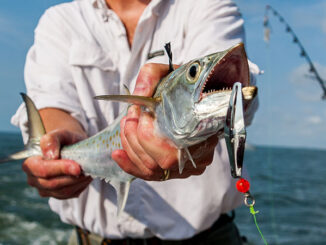
Spanish mackerel are here and hungry
Fishing season awakens each year in April along North Carolina’s central coast. Nearshore and inshore waters begin to warm, attracting predator and prey species. And the bite suddenly comes alive as large Spanish mackerel, chopper bluefish and bonito follow baitfish into nearshore waters.
“We usually get a southwest wind in April, and water temperatures get into the mid-60s,” said guide Noah Lynk of Harkers Island, N.C. “The most-abundant baitfish are glass minnows and finger mullet. In April we catch some of the biggest Spanish of the year, a few weighing 7 ½ pounds. (Menhaden) come in a month later, and cobia follow them.”
Lynk’s favorite spring spot to find these voracious cousins of king mackerel is near the famed 2,500-foot rock jetty that juts out several hundred yards to the southwest from the shoreline near the cape.
“The water temperature is usually 4 to 6 degrees higher there, and it draws baitfish,” said Lynk (252-342-6911). “A lot of people don’t realize Cape Lookout sits directly west of the (Bardens Inlet) sea buoy, so deep water is right there. If you’re fishing near the jetty, it’s the same as being 3 to 5 miles offshore, only there’s that big piece of structure.”
During April, Spanish mackerel swim off the beaches from Shackleford Banks to Ocracoke Island.
Trolling is effective, but casting is a lot of fun
“A lot of people like to go offshore to wrecks, but I like the rock jetty,” Lynk said. “Big charter boats — 50- to 60-footers — sometimes see me fishing at the jetty and come out to troll.”
Trolling is a favorite method to load a boat with Spanish, but if Lynk sees pods of baitfish chased to the surface, he’ll break out casting rods.
“I’ll troll bigger Clarkspoons, but I don’t use planers,” Lynk said. “I’ll troll two medium-action spinning rods with 4000 Series reels spooled with 12- to 15-pound braid. If I use leaders, I like 30-pound P-Line fluorocarbon, just enough to keep a fish’s teeth off the leader.”
If Lynk chooses to combine trolling presentations, he’ll run two hand lines with Clarkspoons off the stern, and mini-teasers — tiny plastic squids — in tandem.
Work the lures fast for Spanish mackerel
“They run a couple inches under the surface, kind of like a squid for dolphin. It can cover a few feet down, and one of the two usually will catch a Spanish.”
If Lynk finds a school of Spanish on the surface, he’ll hand clients rods fitted with 2- or 3-inch Halco Twisty jigs, Clark Spoon stick jigs, minnow jigs, small menhaden jigs or a modified squid spoon for more casting distance.
“The thing about casting and retrieving Spanish lures is you’ve got to crank fast, really burn ’em,” Lynk said. “You have to remember, if you’re trolling you have to run 6 ½ knots or Spanish won’t pay attention to them. That means if you’re casting at them, you have to retrieve them fast.
“If we get into (a thick school), we also can catch Spanish with small Yo-Zuri divers.”
Great-tasting Atlantic bonito, mixed with Spanish, will hit the same lures.
Spanish and bonito sometimes follow spring baitfish so close to shore that pier anglers catch them.




Be the first to comment